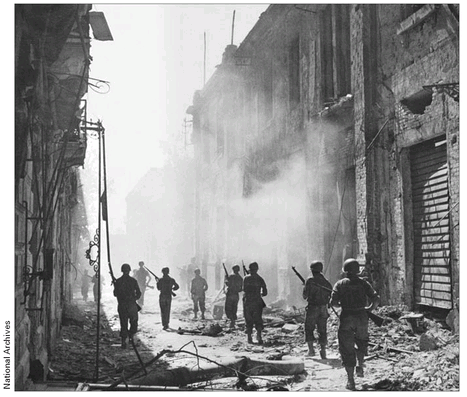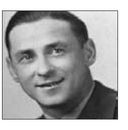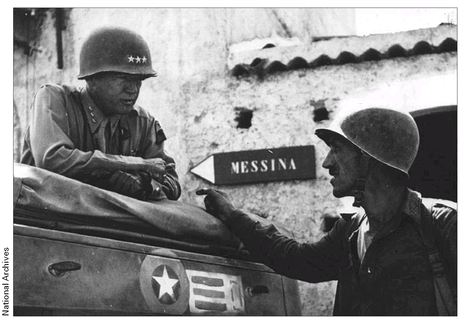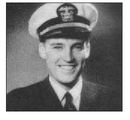War Stories III (17 page)
Authors: Oliver L. North

Sergeant Dyas and the surviving paratroopers of his little band became POWs. They were taken to an internment camp outside Naples, Italy, and then shipped in boxcars to Germany, where they remained for the next twenty-two months.
Â
American troops walk through a damaged Sicilian city.

But for the paratroopers still fighting on Sicily, their ordeal wasn't over yet. Early on 11 July, in a hand-to-hand battle on “Bloody Ridge” overlooking the Gela landing beaches, the American 1st Infantry Division and small groups of paratroopers repulsed a German armored counter-attack. But in so doing, they suffered more than 1,000 casualties.
Patton decided to commit some of his reservesâtwo battalions of the 504th Parachute Infantry Regiment, waiting in North Africa. Since no airfields were yet available for landing in the U.S. zone of action on Sicily, it was decided that the 1,800 paratroopers would parachute inside American lines near Gela.
Tragically, the C-47 transports carrying the paratroopers passed over the invasion fleet just minutes after a German air raid had sunk an LST. Nervous U.S. Navy gunners opened fire on the American aircraft as they approached the drop zones, straight and level at 1,200 feet, downing twenty-three and damaging thirty-seven of the C-47s. Sixty pilots and crewmen, along with eighty-one paratroopers, were killed.
Though their losses were higher than any other units in Husky, the paratroopers had bought precious time for the troops on the beaches and kept them from being pushed back into the sea. For twenty-five-year-old Oklahoma native 2nd Lieutenant Ed Speairs of the 45th Infantry Division, the hours purchased by paratrooper blood made the difference on D-Day.
SECOND LIEUTENANT A. H. “ED” SPEAIRS, US ARMY
45th Infantry Division
Messina, Sicily
17 August 1943
Messina, Sicily
17 August 1943

The morning of July 10, 1943, is a day I'll remember for the rest of my life. Right after dawn I went up on deck to watch the pre-H-hour bombardment. All you could seeâfrom horizon to horizonâwere gray ships. I didn't even know we had so many ships!
I'd joined the National Guard in 1938 and when we were mobilized in 1940, I was promoted to sergeant. Two years later I was a master sergeant and by the time we landed on Sicily, I was a 2nd lieutenant. That morning it was my responsibility for loading thirty-three landing craft with 45th Division troops and then guiding them ashore.
We had left the States on 3 June, escorted by U.S. Navy destroyers and cruisers. When we got to Oran, Algeria, on 22 June, we started amphibious landing exercises. It was a good thing that we'd had the practice in decent weatherâbecause D-Day on Sicily the weather was terrible.
As we headed into the beach the wind was howling and the waves looked like they were twenty feet high. Every time we would drop down in a swell, we would lose sight of the other boats around us. We took a lot of water in and for a while I thought we might sink before we got to the shore.
Somehow I got my boats to the designated beach, but there were rocks that we didn't know about and it delayed some of the boats. Because of the wind and sea conditions it took longer than expected to start getting our tanks ashore. It's a good thing that the German Panzers didn't attack then, because riflemen are no match for armor.
For the next eighty-seven hours all I did was shuttle back and forth between the ships and the beach with my little group of boats. At the end of that timeâbecause of all the damageâhitting rocks, bumping up against the big hulls and the likeâI had just one working landing craft left,
out of thirty-three
. But by then, the ships were unloadedâand the 45th Division had gotten almost all its gear ashore intact.
out of thirty-three
. But by then, the ships were unloadedâand the 45th Division had gotten almost all its gear ashore intact.
On my last trip, I was told to stay ashore and catch up to my unit. They had moved inland about ten kilometersâand I was three and a half days behind them. When I got off on the beach on July 13, practically all I saw were Italian prisonersâthousands of 'em in long lines. They were all smiling, and saying, “I've got a cousin in Brooklyn.” For them, the war was overâbut for us it was just beginning.
There were also bodies of American soldiers on the beach, wrapped in ponchosâwaiting for the graves registration guys. And, there were
mountains of ammo, food, fuel drums, you name itâall waiting to be trucked forward. I caught a ride up to my unit with one of the supply convoys.
mountains of ammo, food, fuel drums, you name itâall waiting to be trucked forward. I caught a ride up to my unit with one of the supply convoys.
We reached Caltanissettaâa town almost in the center of the island, on 17 or 18 July. This place had been a big supply depot for the Italian army and headquarters for the Fascist Party on Sicily and it had been just about leveled by air strikes and artillery fire. There was the smell of death everywhere, and as we came to discover, there were lots of bodies of German and Italian troops in the rubble.
Patton pushed everyone very hard to keep the enemy on the run. Palermo, the capital of Sicily, was captured on 22 Julyâbut then it became obvious that the Germans had sent in reinforcementsâand that slowed everything down.
The Germans also began to use lots of mines on the roadsâand to blow up all the bridges and roadways they could to delay our advance. Later on, at Cefalù, on the northwest coast, the Germans used explosives to shear off the road that had been built on the edge of a cliff over the sea. The Germans just blasted it off.
But Patton wanted us to keep pressing ahead, so our engineers came up and used bridge sections to cross the gap so that we could keep going. And they did it all while under fireâit was an incredible feat. I'm glad I went all the way with Patton.
Lt. Ed Speairs' observations about Patton's pressure to keep driving forwardâand the heroic acts that he inspiredâwere right on the mark. The 7th Army commander had come ashore on D-Day and shortly thereafter reported, “We have them on the run” and he wanted to keep them that way.
Certain that the Germans had been surprised by the Allied landings, Patton unrelentingly pressed his troops forwardâbefore their enemy could reinforce or escape across the narrow Strait of Messina. And he almost succeeded.
Hitler
had
been totally surprised by Husky. He not only believed the inaccurate intelligence he'd received about the Allies heading for the
Balkans or Sardinia, but the Führer was also distracted by giving so much of his attention to Operation Citadelâthe offensive he had launched in the Crimea near Kursk. But once Hitler realized what was
really
happening on Sicily, he moved swiftly.
had
been totally surprised by Husky. He not only believed the inaccurate intelligence he'd received about the Allies heading for the
Balkans or Sardinia, but the Führer was also distracted by giving so much of his attention to Operation Citadelâthe offensive he had launched in the Crimea near Kursk. But once Hitler realized what was
really
happening on Sicily, he moved swiftly.
On 13 July, Hitler ordered the Kursk offensive haltedâit was already a disaster for the Wehrmachtâso that reserves headed for the Eastern Front could instead be sent to Italy. At his “Wolf's Lair” headquarters in East Prussia on 17 July, the Führer told his general staff, “Barbaric measures are needed to save Italy. Only by terrifying the Italian population into blind obedience, can we stiffen Italian resistance.” Acting on that premise, he flew to Feltre, north of Venice, to meet with Mussolini on 19 July. The next day he ordered the 29th Panzergrenadier and the 1st Parachute Division to Sicily.
Hitler's last-minute intervention wasn't enough to save his fellow Fascist. On 23 July, Patton marched triumphantly into Palermo, Sicily's capital. And three days later, Mussolini was imprisoned.
Â
General Patton on his way to Messina.

Patton's capture of Palermo may have precipitated the fall of the dictator, but it didn't end the fighting on the island. German reinforcements halted Montgomery's push to Messina dead in its tracks at Mount Etna. By 31 July, Patton's advance through central Sicily and along the island's northern coast had been slowed as well.
Undeterred, and adamant that he'd reach Messina before Montgomery, the U.S. Army's most famous armor tactician showed that he also had a firm grasp of amphibious warfare. Starting on 8 August, with the help of the U.S. Navy, Patton launched a series of short “amphibious hooks” along Sicily's north coast, leapfrogging his battalions beyond German strong points on the approach to Messina. Small vessels like Sub-chaser-692, commanded by twenty-four-year-old Lt. (JG) Edward Stafford, were essential to the success of these operations.
LIEUTENANT (JG) EDWARD STAFFORD, USN
Sub-Chaser SCE-692
18 August 1943
18 August 1943

I joined the Navy because my grandfather had served in the Navy. I spent every summer with him on the coast of Maine, learning how to handle small boats and about tides and currents. I got my commission on 16 September 1941, just before Pearl Harbor and took command of SCE-692, a sub-chaser, in January of '43.
On D-Day in Sicily the weather was terribleâand the surf on the landing beaches was worse. I was nervousâthis was my first experience in combatâand every one of us aboard that little ship were Navy reservists. The first class boson's mateâthe senior enlisted manâwas a big help, and an “old salt.” He must have been thirty-three. We were the smallest class of ship to make the transatlantic crossing in a huge convoy. There were a lot of these small ships brought over for the Sicily operationâeven though we were designed for anti-submarine patrols off the U.S. coasts.
On D-Day our job was to meet a wave of landing craftâfive or six loaded LCVPs, Higgins boats near the transports, escort them to the line of departure, two miles off shore, and get them all on line and properly positioned for their run into the beach. Once the wave of boats started in, we'd head back out to the transport ships and pick up another wave and repeat the whole process.
But on the morning of 10 July, there was this horrible sea with ten-and fifteen-foot waves and this howling windâand packed into each of these little landing craft are twenty to thirty soldiers all loaded up with all their weapons and equipment. I thought that someone would surely cancel the landing until the wind and sea quieted someâbut I guess if we had done that we would have lost the element of surprise. That's a hell of a choice to makeâand I'm glad I didn't have to decide it.
Somehow, we managed to get all our boat waves safely onto the beach but a few hours into the landing, German aircraftâStukas and fightersâattacked us. They hit one of the 1st Division's LSTs on the beach, and she caught fire. We could see the smoke coming up from her. Surprisingly, there were very few casualties getting people ashore.
On 22 Julyâjust twelve days after the landingâthe 7th Army captured Palermo. The next day, Patton entered the city and we were the first ship to enter the Palermo harbor. It hadn't even been swept for mines when we came in.
There were wrecks all across the middle of the harbor. A shipâit must have weighed 2,000 tonsâwas sitting not
at
the dock, but
on
the dock. It had been blown out of the water, presumably by an American air raid, and the explosion lifted it onto the pier. We all went ashore and it was fantastic. The capital city of Sicily was a ghost town.
at
the dock, but
on
the dock. It had been blown out of the water, presumably by an American air raid, and the explosion lifted it onto the pier. We all went ashore and it was fantastic. The capital city of Sicily was a ghost town.
A few weeks later, Patton's troops were running into all kinds of opposition on the route along the north coast to Messina. The Germans had blown up all the bridges on the coast highwayâand were contesting at every turn on the road. So Patton decided that he would just bypass these roadblocks and obstacles with a number of amphibious operationsâsmaller versions of what we had done on July 10.
Because the coastal waters hadn't been swept and the charts weren't very good, little vessels like sub-chasers and destroyer escorts were perfect for these assaults. Ships like ours were able to not only escort the landing craft into the beach but could also stay in close to provide gunfire support. That's how Patton beat Montgomery to Messinaâand the little ships of the U.S. Navy helped him do it.
Other books
Warbreaker by Brandon Sanderson
Anna and the French Kiss by Stephanie Perkins
Vermilion Kiss by Elisabeth Morgan Popolow
Witch & Wizard 04 - The Kiss by James Patterson
La pella by José Ángel Mañas
Changelings by Anne McCaffrey
Unsympathetic Magic by Resnick, Laura
Girl to Come Home To by Grace Livingston Hill
Hold the Light by Ryan Sherwood
The Possession of Mr Cave by Matt Haig
